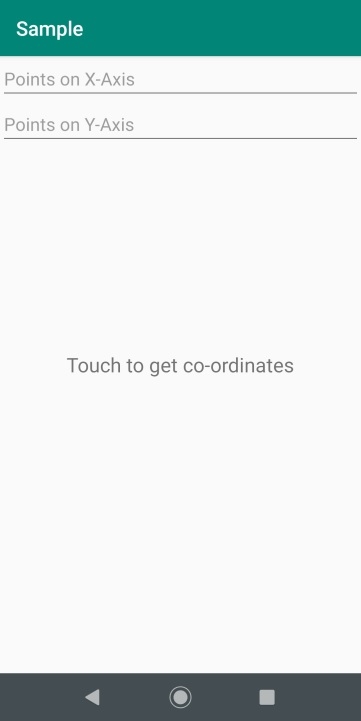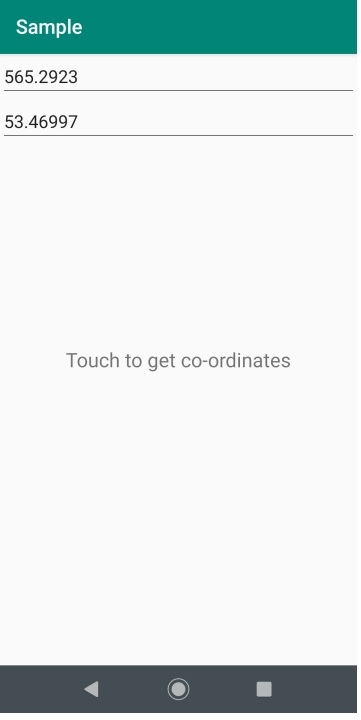
 Data Structure
Data Structure Networking
Networking RDBMS
RDBMS Operating System
Operating System Java
Java MS Excel
MS Excel iOS
iOS HTML
HTML CSS
CSS Android
Android Python
Python C Programming
C Programming C++
C++ C#
C# MongoDB
MongoDB MySQL
MySQL Javascript
Javascript PHP
PHP
- Selected Reading
- UPSC IAS Exams Notes
- Developer's Best Practices
- Questions and Answers
- Effective Resume Writing
- HR Interview Questions
- Computer Glossary
- Who is Who
How to get the touch position on android device?
This example demonstrates about how do I get the touch position on android device.
Step 1 − Create a new project in Android Studio, go to File ⇒ New Project and fill all required details to create a new project
Step 2 − Add the following code to res/layout/activity_main.xml.
<?xml version="1.0" encoding="utf-8"?> <RelativeLayout xmlns:android="http://schemas.android.com/apk/res/android" xmlns:tools="http://schemas.android.com/tools" android:layout_width="match_parent" android:layout_height="match_parent" tools:context="MainActivity"> <EditText android:layout_width="400dp" android:layout_height="wrap_content" android:id="@+id/editText" android:hint="Points on X-Axis" /> <EditText android:layout_width="wrap_content" android:layout_height="wrap_content" android:id="@+id/editText2" android:layout_below="@+id/editText" android:layout_alignLeft="@+id/editText" android:layout_alignStart="@+id/editText" android:hint="Points on Y-Axis" android:layout_alignRight="@+id/editText" android:layout_alignEnd="@+id/editText" /> <TextView android:layout_width="wrap_content" android:layout_height="wrap_content" android:text="Touch to get co-ordinates" android:id="@+id/textview" android:focusable="true" android:clickable="true" android:textSize="20dp" android:layout_centerVertical="true" android:layout_centerHorizontal="true" /> </RelativeLayout>
Step 3 − Add the following code to src/MainActivity.java
package app.com.sample;
import android.support.v7.app.AppCompatActivity;
import android.os.Bundle;
import android.view.MotionEvent;
import android.view.View;
import android.widget.EditText;
import android.widget.TextView;
public class MainActivity extends AppCompatActivity {
TextView T;
EditText E1, E2;
float x = 0f;
float y = 0f;
@Override
protected void onCreate(Bundle savedInstanceState){
super.onCreate(savedInstanceState);
setContentView(R.layout.activity_main);
E1 = (EditText) findViewById(R.id.editText);
E2 = (EditText) findViewById(R.id.editText2);
T=(TextView)findViewById(R.id.textview);
T.setOnTouchListener(new View.OnTouchListener(){
@Override
public boolean onTouch(View v, MotionEvent event) {
final float x = event.getX();
final float y = event.getY();
float lastXAxis = x;
float lastYAxis = y;
E1.setText(Float.toString(lastXAxis));
E2.setText(Float.toString(lastYAxis));
return true;
}
});
}
}
Step 4 − Add the following code to androidManifest.xml
<?xml version="1.0" encoding="utf-8"?> <manifest xmlns:android="http://schemas.android.com/apk/res/android" package="app.com.sample> <application android:allowBackup="true" android:icon="@mipmap/ic_launcher" android:label="@string/app_name" android:supportsRtl="true" android:theme="@style/AppTheme"> <activity android:name=".MainActivity"> <intent-filter> <action android:name="android.intent.action.MAIN" /> <category android:name="android.intent.category.LAUNCHER" /> </intent-filter> </activity> </application> </manifest>
Let's try to run your application. I assume you have connected your actual Android Mobile device with your computer. To run the app from android studio, open one of your project's activity files and click Run ![]() icon from the toolbar. Select your mobile device as an option and then check your mobile device which will display your default screen −
icon from the toolbar. Select your mobile device as an option and then check your mobile device which will display your default screen −


Click here to download the project code.

